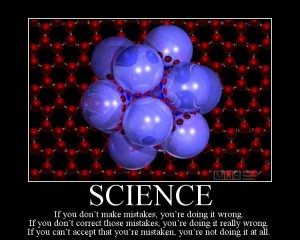One of my most comforting thoughts comes from the following quote I once heard:
Over the long term science is self-correcting
Another one that I like is:
The free, unhampered exchange of ideas and scientific conclusions is necessary for the sound development of Science, as it is in all spheres of life.’ (Albert Einstein, 1952)
I happen to think that with ISO/IEC 17025, ILAC Guide 19 and the efforts of ASTM E11 committee in conjunction with the National Academy of Science’s February report to Congress and the Senate Judiciary Draft Legislation, we in the forensic science community are experiencing exactly that.
It is an exciting time.
I have hope…..
Then I read this.
JR Minkel, “Fear Review: Critique of Forensic Psychopathy Scale Delayed 3 Years by Threat of Lawsuit: Does an academic’s use of legal threats to stop a critical paper from being published subvert the peer review process, which is fundamental to modern scientific research?” Scientific American (June 17, 2010)
Minkel details how the very threat of a law suit by another scientist delayed the publishing and forced “corrections” of an article that survived the scrutiny of peer-reviewed. He writes:
A leading psychopathy researcher has used the threat of legal action to have changes made to a research paper critical of a widely used criminological rating scale he developed 20 years ago. In the process the paper, which was accepted for publication in 2007 by Psychological Assessment, was delayed three years. It finally appeared in the journal’s June issue, but the whole affair has raised questions about how legal threats can impact the progress of psychological science.
The article in question concerns the Hare Psychopathy Checklist–Revised (PCL-R), which is commonly administered in serious criminal cases to help make sentencing decisions as well as in prisons and psychiatric hospitals to determine suitability for release. A high score on the PCL-R is used to diagnose psychopathy.
People familiar with the matter say the scale’s author, Robert Hare of the University of British Columbia, deserves only partial blame for the delay, to be shared with the American Psychological Association (APA), the journal’s publisher. But they say Hare’s use of legal threats has at best subverted the peer review process that is the crux of modern scientific progress, and could at worst encourage junior researchers in the field of forensic psychology to pursue other lines of research.
“I find this action to be completely inconsistent with the man I had [great] respect and affection for,” says Stephen Hart of Simon Fraser University in British Columbia, a collaborator and former student of Hare’s. “People I speak with automatically think, ‘Well, what’s in that article that makes him so upset? What’s he so afraid of?'”
In their finally published critique of the Hare checklist, Jennifer Skeem of the University of California, Irvine, and David Cooke of Glasgow Caledonian University argue that forensic psychologists and psychiatrists have wrongly come to view the PCL-R as a complete description of psychopathy. They say it leaves out certain characteristics such as low anxiety that are central to the disorder and focuses too much on criminal behavior. These features may “promote overdiagnosis of psychopathy,” they wrote.
According to a document Hare has circulated to journalists and other researchers, Skeem and Cooke’s original manuscript misrepresented Hare’s work by incorrectly paraphrasing a 2005 paper published in Current Psychiatry Reports, taking words out of context from it and other papers to support the argument that researchers have viewed criminal behavior as “important” or “central” to psychopathy.
Based on this disagreement and others Hare and a colleague lobbied a senior editor of Psychological Assessment to get Skeem and Cooke to reexamine their paper, which had already passed peer review, and make revisions. But Hare says the subsequent revisions were minimal, and after consulting with his lawyer he threatened to sue for defamation if the paper was published in its then current form. The APA then appointed a new group of editorial reviewers, who requested additional changes from the authors. “It was [a] shock,” Skeem says of Hare’s legal threat. “This is not about Professor Hare, and it’s only incidentally about the Psychopathy Checklist,” she says. “The focus was really on how we could move the field forward.” Skeem says she now worries that papers she submits for review will be labeled as biased.
The situation could have been worse: In 2008 the British Chiropractic Association sued U.K. writer Simon Singh for libel after he wrote in the Guardian that the group “happily promotes bogus treatments.” Although a judge initially ruled that Singh’s words constituted an assertion of fact, which would have made it hard for him to win a trial case, in April 2010 an appeals court found that his statement qualified as “fair comment” and was therefore protected. Back in the academic world APA publisher Gary VandenBos says he has fielded 20 to 30 legal threats similar to the current one in his 25-year tenure. “The APA has always published any article that was challenged,” VandenBos says, “but APA…has a responsibility to all parties to evaluate a legal claim.”
Such tactics really are the enemy of academics and of the organic progression of science. It is contra the scientific method. Shame on Robert Hare. The poster below aptly describes what science should be….




solicitors says:
^_^ cool blog man